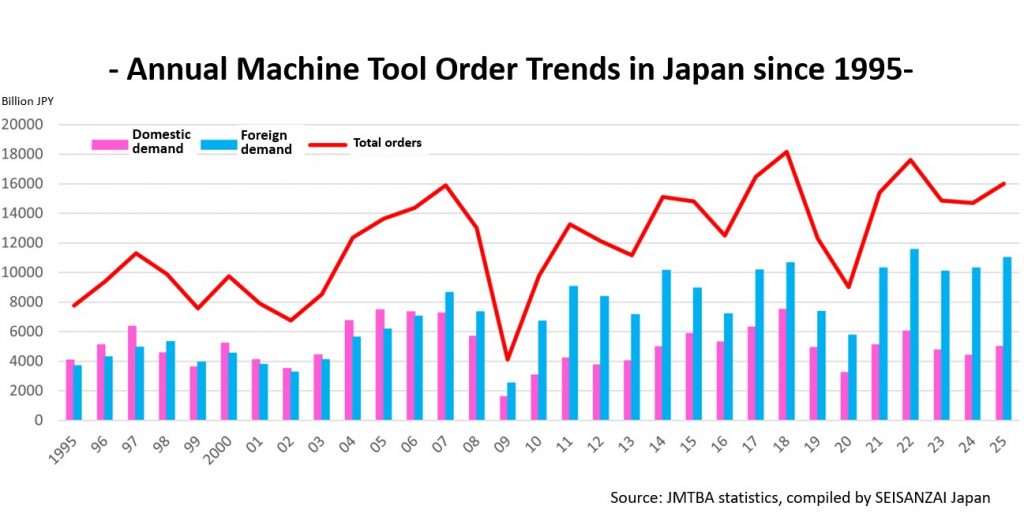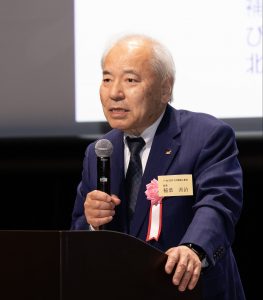
- News
- Basics
- Products
- JP Job shop
- Exhibition
- Interview
- Statistic
- PR
- Download
- Special contents
Statistic
February 10, 2025

News Digest Publishing (ND), the organization behind SEISANZAI Japan, hosted the “2025 FA Industry New Year’s Reception” on January 10. During the event, Dr. Yoshiharu Inaba, chairman of the Japan Machine Tool Builders’ Association (JMTBA), presented the JMTBA’s industry outlook for 2025, forecasting a total of 1,600 billion yen in machine tool orders, up 8.8% from 2024.
Related Article: 700 industry leaders gather for 2025 FA Industry New Year’s Reception

Dr. Yoshiharu Inaba, chairman of the Japan Machine Tool Builders’ Association (JMTBA)
The JMTBA reported that Japan’s total machine tool orders for 2024 were 1,485 billion yen, with domestic orders at 441.5 billion yen and overseas orders at 1,043.5 billion yen. This marks the second consecutive year of decline in total orders.
Dr. Inaba, who also serves as Chairman of FANUC, commented, “While the U.S. and China remained strong, the European market was particularly tough, and domestic demand in Japan also struggled. However, with total orders exceeding 1,400 billion yen for the fourth consecutive year, the figures are not entirely negative.”
Japan’s machine tool industry experienced a sharp decline in orders in May 2020 due to the COVID-19 pandemic, followed by a recovery that peaked in March 2022. However, this peak was partly due to front-loading of orders due to supply chain disruptions and long lead times for machine tools. Since then, the market has been in a correction phase.
Dr. Inaba also noted that revisions in battery electric vehicle (BEV) development strategies, particularly in Europe and the U.S., have affected capital investment. While BEV development is being delayed, investment in hybrid electric vehicles (HEVs) is moving forward. He added that in China, demand for BEVs and IT-related equipment has returned to a growth trajectory, supported by government subsidy incentives in 2024.
JMTBA forecasts that Japan’s machine tool orders will grow 8.8% year-on-year to 1,600 billion yen in 2025, with domestic orders up 13.6% to 500 billion yen and foreign orders up 6.8% to 1,100 billion yen.
While the first half of 2025 is expected to follow the current sluggish trend, a gradual recovery is expected in the second half of the year, leading to a moderate market upturn.
“The key factor will be domestic demand. Given the continued yen depreciation, reshoring is expected to accelerate,” Dr. Inaba said. Despite challenges such as labor shortages and an aging workforce, automation and intelligent manufacturing technologies have become increasingly sophisticated. He emphasized that reshoring is a critical issue for the future of Japan’s manufacturing sector.
Another point Dr. Inaba addressed was the urgent need for equipment renewal in Japan. “Japan’s manufacturing equipment is among the oldest in the world,” he said, noting that more than 45% of the machines in operation are more than 10 years old.
“Traditionally, maintaining and using old machines for as long as possible has been considered a virtue in Japan. Today, however, we must also consider production efficiency and environmental performance,” he stressed.
JMTBA has been urging the government to support equipment upgrades, and its efforts have borne fruit; the Japanese Ministry of Economy, Trade and Industry (METI) included the replacement of aging equipment in the draft Basic Energy Plan announced on December 17, 2024.
“We will work to achieve our 2025 order forecast, including promoting equipment renewal initiatives,” Dr. Inaba concluded.
January 29, 2025